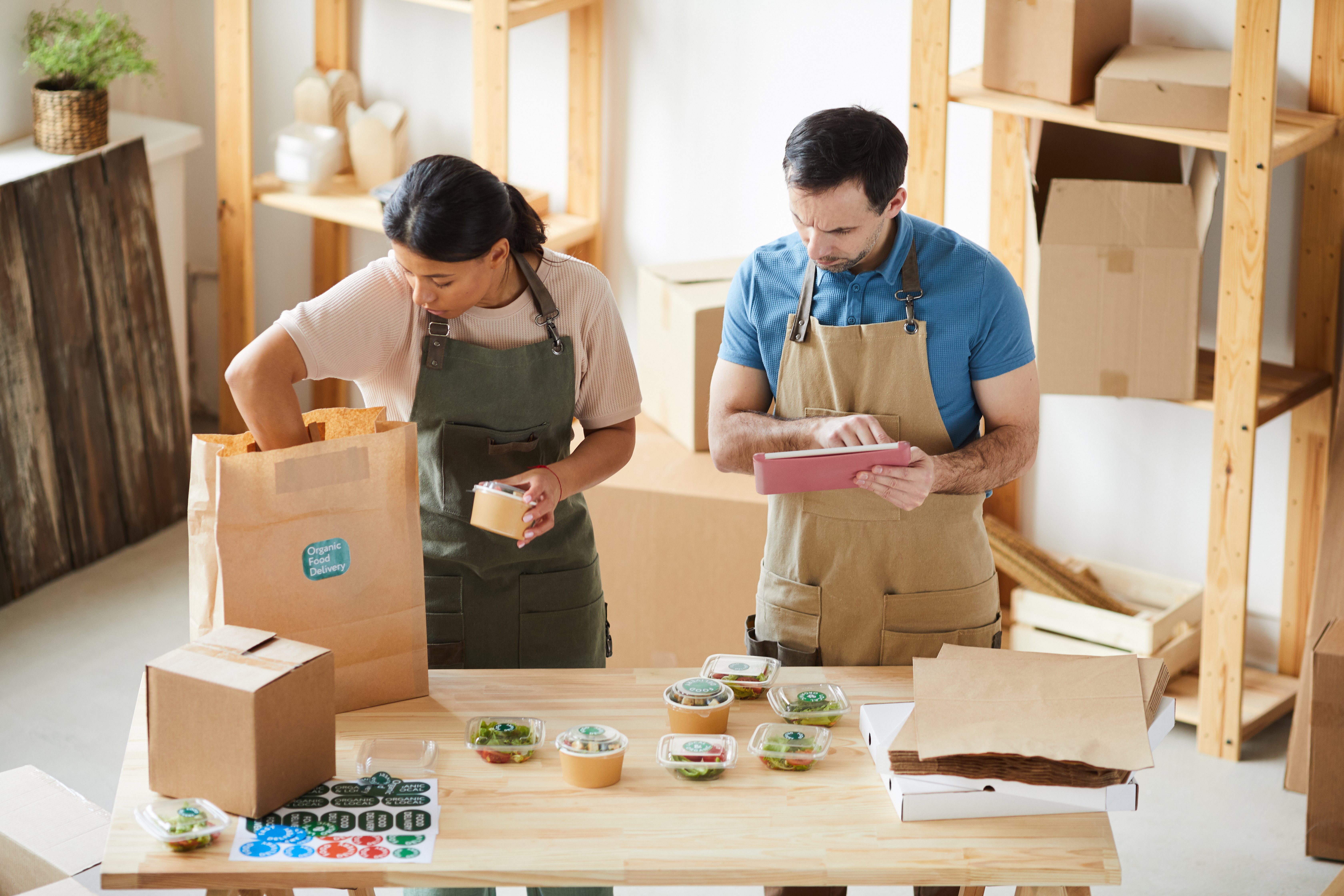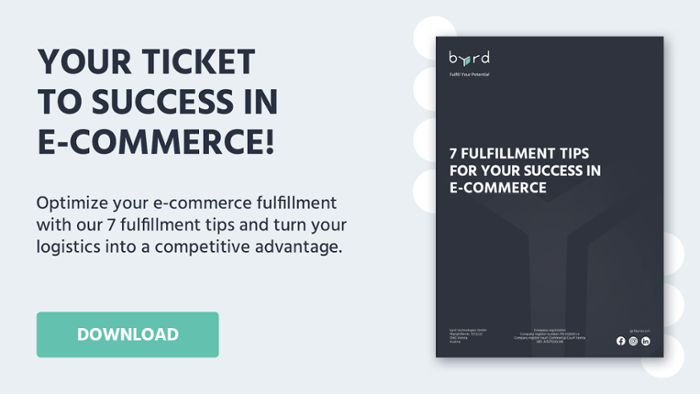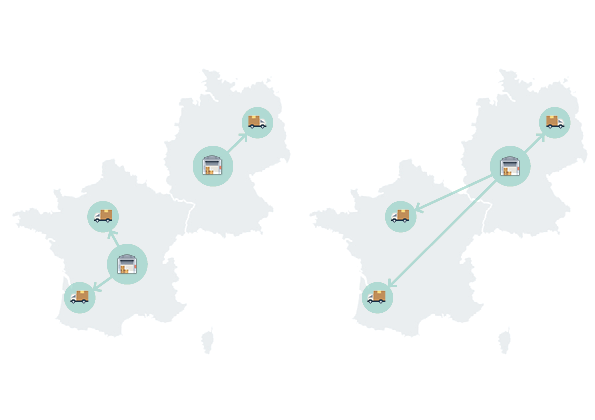Optimize your order fulfillment process: the 3 main challenges
Table of Content
In 2020, the global coronavirus outbreak drastically altered both our social interactions and our online shopping habits. Sales increased by 18% that year, and the numbers have continued to grow ever since. By 2023, global e-commerce sales alone reached an estimated $5.8 trillion. With such high demand, there is increasing emphasis on expanding online sales and improving order-handling processes.
The explosion of online sales has deeply impacted order fulfillment! From an outside perspective, you could say “ Nice, there is money to make in the e-commerce industry. Let’s launch a Shopify shop and sell doormats! ”
But from an inside perspective, it’s more complicated. Higher online traffic means higher sales. And if you start to sell more and more products online, sooner than later, you’ll face many challenges when it comes to handling order fulfillment in order to ensure customer satisfaction.
Customer expectations in 2024
With the ongoing rise of e-commerce and digitization, customers are demanding more and more personalized and seamless experiences at every touch point when shopping online. Online businesses are being driven to decentralize their logistics and operations to improve the expectations of their customers.
Challenges that, when solved, become opportunities for them to create a differentiated customer experience, satisfy shoppers and win their loyalty.
Acceleration of e-commerce and emerging consumer expectations
We’ve seen brands like Shopify innovate and push new functionalities into the market. More merchants than ever start exploring tech partnerships with brands that can help them make more sales online and deliver a better customer experience.
And while that tremendous growth is great news for anyone in the e-commerce space, consumers’ reliance on online shopping has also led to an increase in expectations.
Brands like Amazon have raised the bar for everyone across any vertical in the e-commerce space.
Now, consumers have been conditioned to expect 3 things while they shop online :
- Speed
- Simplicity
- Transparency
Whether you like it or not, DTC merchants are being held to the same standard as multinational, multi-billion dollar organizations. The time for online merchants to adapt their pre and post-purchasing journey has come.
That is why it's time for only merchants to adapt and improve their post-purchase experience. In the next section, we're going to explain how you can leverage your order fulfillment to improve customer satisfaction.
To assure greater customer satisfaction, lower operational complexity and costs as we move forward into the digital-first economy, order fulfillment experts like byrd, and customer experience gurus like Heyday AI can help.
Challenge 1: Handling higher order volumes quickly
The opportunity for DTC brands is to build on their e-commerce expertise. The challenge for everyone else is keeping up. [...] This is not just a pandemic disruption. This is an evolution of the brand and online purchasing.
- Nisha Dua, Co-Founder, and General Partner, BBG Ventures
High online order volumes create shipping delays and slower fulfillment times. How can merchants deliver orders as quickly as possible and assure customer satisfaction?
The challenge here is to balance the consumers’ expectations for fast delivery times and a good purchasing experience. This is where DTC brands and e-merchants have an opportunity. By working on their fulfillment process to make it as smooth as possible, they can improve customer experience and satisfaction. For instance, flexibility and decentralized fulfillment networks can help them shorten delivery times and make online shoppers happy.
73.6% of shoppers consider shipping to be a crucial part of their overall shopping experience.
Flexibility and decentralized logistics to handle your order fulfillment process
Two ways to handle higher order volumes are improving your flexibility and changing your logistics process.
Offering flexible shipping and delivery
In this case, you should consider going through the following 2 steps:
1. Offer alternative delivery methods and match your customer’s expectations
If you look at the number, you’ll see that consumers are very different:
Take France for instance. When it comes to choosing a parcel delivery company, French consumers are more likely to choose a local carrier.
As a consequence, offering several delivery options can help you to improve your conversion rates as well as increase your average cart sizes. To do that, you should both know who your customers are, and the specificity of the targeted market
2. Be prepared with reliable delivery
Moreover, having flexible shipping options available is beneficial during peak times when shipping service providers are likely to have technical or operational issues.
We gathered for you the best delivery providers in France, Italy, Spain, Poland, the Netherlands, the UK, and Germany in case you need more information.
Benefits of a decentralized logistics network
A decentralized logistics network with several warehouses has proven to be especially important in times of a pandemic since it can enable companies to remain operational when one warehouse has to be shut down.
One important advantage is that a decentralized logistics network can diversify the supply chain, making it more stable and resilient.
In that regard, if you have the opportunity, you should think of decentralizing your logistics network for risk-free fulfillment. Partner with 3PL companies with hyper-local fulfillment centers to cut down delivery times and costs is one solution. Especially if that partner has a vast network of strategically located fulfillment centers in the regions you want to ship to. This allows you to stock the right merchandise at the right location so orders can be shipped faster and routed more efficiently.
Challenge 2: Preventing returns and making the order fulfillment frictionless
Retailers need to get creative to reduce returns because returns can destroy a business.
- Jordan Knapp, Head of New Markets, Shopify
The second challenge, and certainly not the smallest one, is related to the return process. In 2023, the reverse logistics market was estimated at $700 billion globally and is forecast to grow by 36% to $954.5 billion by 2029. And as online consumers embrace the digital shopping revolution, rising expectations have made returns a regular aspect of the customer experience
Internal data from byrd shows that retailers experience a sharp increase in returns after peak season business - in 2020 the number of returns surged by 150% in January compared to the rest of the year (2019).
Therefore, the question is: how can merchants remove friction in their return process for shoppers, while reducing the overall volume of returns? Because yes, having the best and smoothest return process is a competitive advantage. But let’s not forget that the main objective is to have as few returns as possible.
What to do regarding returns and the return process?
Despite all the data, you can find online about massive return costs, you can also find that there is a switch going on.
Merchants have realized that returns are somehow inevitable. 23% of merchants want to improve their returns management in the next 24 months. It is part of any e-commerce activity. Since the consumer cannot touch or see the product, there is a risk when a purchase is made.
One of the solutions is to work on your pre-purchase process:
- Have an optimized e-commerce platform
- Work on your product presentation, images, description
- Have an automated FAQ
- Increase your social media presence with more content and interaction with your customers
The other solution is to work on your post-purchase process: the return process. According to Shopify’s Future of Commerce 2021 report, 40% of shoppers agree that fast and free returns would make online shopping better.
Automation can help merchants win back shoppers with a quick and painless returns process. The investment in automation makes business sense. 96% of consumers will shop with a retailer again based on an “easy” or “very easy” return experience.
Through automation, merchants can automate returns and instantly give shoppers store credit, pre-fill return labels, and support self-serve returns, and help shoppers track the progress of their return with push notifications via SMS, email, or chat.
The pandemic has amplified the consumer’s desire for convenience and immediacy. Make sure your customers can choose where and how they return products, whether it’s in-store, online, by contacting support, or via an AI-powered virtual assistant.
Improving customer enthusiasm
67% of e-shoppers opt to buy only if the return policy seems favorable to them. And 92% of consumers stated that they would buy again if the product return process is easy. A customer-focused, simple returns process reduces their fear of loss and increases their trust in your brand.
That helps you, as an online business to retain them as a customer, even if you lose the initial sale. We collectively need to see returns as an opportunity to inspire confidence in our customers and earn their trust. And the long-term benefit of that is higher customer lifetime value (CLTV).
Challenge 3: Being quick, effective, and transparent when it comes to order fulfillment
Higher order volumes lead to one big issue for retailers: handling more customer requests and claims such as:
- Tracking
- Product information
- Delivery times and delays
Consumers have a lack of visibility on their orders as a result of either multiple shipments for the same order, or multiple concurrent orders. With that in mind, merchants that invest in offering order consolidation and automating responses to FAQs such as “where’s my order?” (or WISMO) stand to differentiate their order fulfillment experience from the pack.
Consolidating orders
Let’s say you purchase 5 different products in the same order. Several things can happen. Either you receive all of the items in one shipment, or you receive them at disparate times.
In the first scenario, your order was consolidated and shipped from the same distribution center. Receiving all products at the same time is convenient (and better for the environment), but you may receive the items slower.
In the second scenario, the items were either shipped from different distribution centers, shipped as they became available, or shipped with different carriers. This order fulfillment strategy is anchored on speed, with no regard for carbon emissions or the disjointed experience it produces.
Order consolidation is an increasingly popular option, both for retailers and consumers. From the retailer’s point of view, it helps them save on shipping costs. For shoppers, they get everything they ordered at the same time and reduce their carbon footprint. Sure, their order may take a little longer to arrive, but shoppers are willing to sacrifice shipment speed to reduce their carbon footprint.

Automating FAQs
When our partners at Heyday AI analyzed over 1 million support conversations via retailers’ chat channels, they found that 40% of conversations had to do with order tracking.
This data is interesting for a few reasons - for one, if shoppers are proactively asking retailers about the status of their order, it suggests retailers are not proactively giving shoppers that information. This puts an unnecessary onus on the shopper to follow up on their orders, which can result in friction in the customer experience (and a backlog of support requests for a subject that is ripe for automation).
By automating FAQs, especially those related to order tracking, shoppers can get real-time responses to their pressing questions, resulting in a more transparent shopping experience.
Chat is becoming an increasingly used channel for giving shoppers real-time support via a blend of automation, live chat, and video. Frequently asked questions (like “where’s my order?”) can be solved with automated responses, while shoppers can turn to live chat for more complicated issues.
As we move into the digital age, we’ll likely see retailers continue to open up chat as a channel to foster real-time dialog and serve their customers better.
Conclusion
Order fulfillment will be a key differentiator for DTC brands in 2024 and beyond. Those who make order fulfillment a simple, transparent, and frictionless experience are positioned to thrive and win customer loyalty.
|
If you want to learn more about order fulfillment, return processes, and automated processes, you can download the webinar presentation (in French) here. And to be informed of our next webinar and event, you can subscribe to our newsletter below! |

